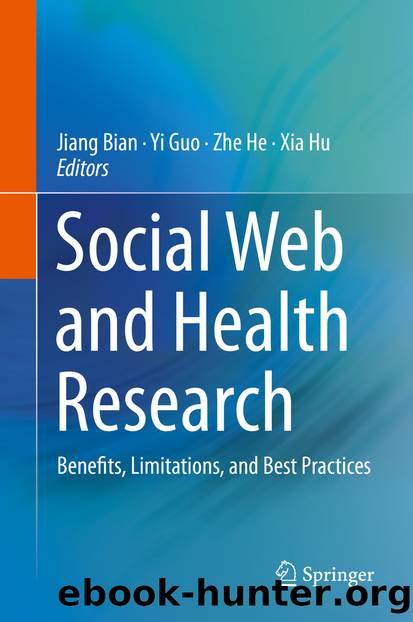Social Web and Health Research by Unknown

Author:Unknown
Language: eng
Format: epub
ISBN: 9783030147143
Publisher: Springer International Publishing
7.4 Content Discussed on Social Media
A growing body of research has been devoted to examine what health-related content are shared on social media, typically by content-analyzing user profiles and posts. Recent attention has also been paid to investigate risky and stigmatized health issues. For example, early research on publicly accessible MySpace profiles showed that displaying information about risky behaviors, including alcohol, drug, and tobacco, is a common practice, especially among teenagers [59]. Similar observation was made on Facebook profiles that over half of college students had posted profile photos in which they engage some extent of alcohol use [22]. Loss et al. [21] also identified alcohol to be the most frequently disclosed risky behavior on Facebook, while they found that a majority (90%) of adolescents’ profiles contain risky behavior. A study content analyzed over 5000 alcohol and drinking-related tweets and found that pro-drinking tweets outnumbered anti-drinking tweets by 10 to 1 [25]. These authors also identified nearly 12 million alcohol-related Tweets posted in one month, often by celebrities. Other risky behaviors include marijuana use and risky sexual behavior. Another study on marijuana-related tweets posted by adolescents demonstrated that 65.6% of the tweets aired positive attitudes toward the substance and 42.9% indicated personal use. Again in the Twitter space, McLaughlin et al. [9] also observed a somewhat “dark side” of Tweeting content related to preexposure prophylaxis (PrEP), an oral drug for HIV prevention. These contents include messages that promote sale of the drug without a prescription and tweets that make moral judgments about user of the drug (i.e., high-risk populations for HIV infection). A content analysis study by Wombacher et al. [17] of 3776 posts on Yik Yak, an anonymous social media platform that is especially popular among college students, showed that risky behaviors were discussed more frequently than healthy behaviors.
People not only share such content on social media, but also build online communities to exchange information and to gain social support. For example, researchers found that like-minded people formed pro-smoking online communities and created virtual smoking clubs [32, 60]. In these communities and clubs, members share pro-smoking messages, pictures of celebrity smokers, vaping experiences, opinions about e-cigarette flavors, and information about various e-cigarettes brands [32, 60]. Pro-extreme dieting community members commonly share information about effective weight loss including the use of weight loss drugs [19, 39, 61–64]. They share photos of thin celebrities as motivation and obese people as warnings. They also support each other in their weight-loss targets and share tips on avoiding detection by professionals and family members when skipping meals. Researchers concluded that overweight people and people of normal weight were seen as being weak in the pro-extreme dieting community, and community members believed that strength and beauty were obtained through thinness [16, 39, 62, 63]. Also, a pro-smoking community, called “Jenny Teen Smoking Page,” provided information about smoker’s rights. Many of the community members were influenced by this information and shared their stories about their initiations to smoking. Many of them kept posting as their smoking habit developed [65].
Download
This site does not store any files on its server. We only index and link to content provided by other sites. Please contact the content providers to delete copyright contents if any and email us, we'll remove relevant links or contents immediately.
Tools of Titans by Timothy Ferriss(6937)
Change Your Questions, Change Your Life by Marilee Adams(6637)
Deep Work by Cal Newport(5452)
Man-made Catastrophes and Risk Information Concealment by Dmitry Chernov & Didier Sornette(4729)
Big Magic: Creative Living Beyond Fear by Elizabeth Gilbert(4719)
The Slight Edge by Jeff Olson(4716)
The Motivation Myth by Jeff Haden(4521)
Digital Minimalism by Cal Newport;(4512)
Stone's Rules by Roger Stone(4413)
Ego Is the Enemy by Ryan Holiday(3982)
The Laws of Human Nature by Robert Greene(3936)
Tuesdays with Morrie by Mitch Albom(3830)
Rising Strong by Brene Brown(3777)
Eat That Frog! by Brian Tracy(3508)
Skin in the Game by Nassim Nicholas Taleb(3456)
The Money Culture by Michael Lewis(3277)
Skin in the Game: Hidden Asymmetries in Daily Life by Nassim Nicholas Taleb(3259)
Believe It to Achieve It by Brian Tracy & Christina Stein(3201)
Bullshit Jobs by David Graeber(3173)
